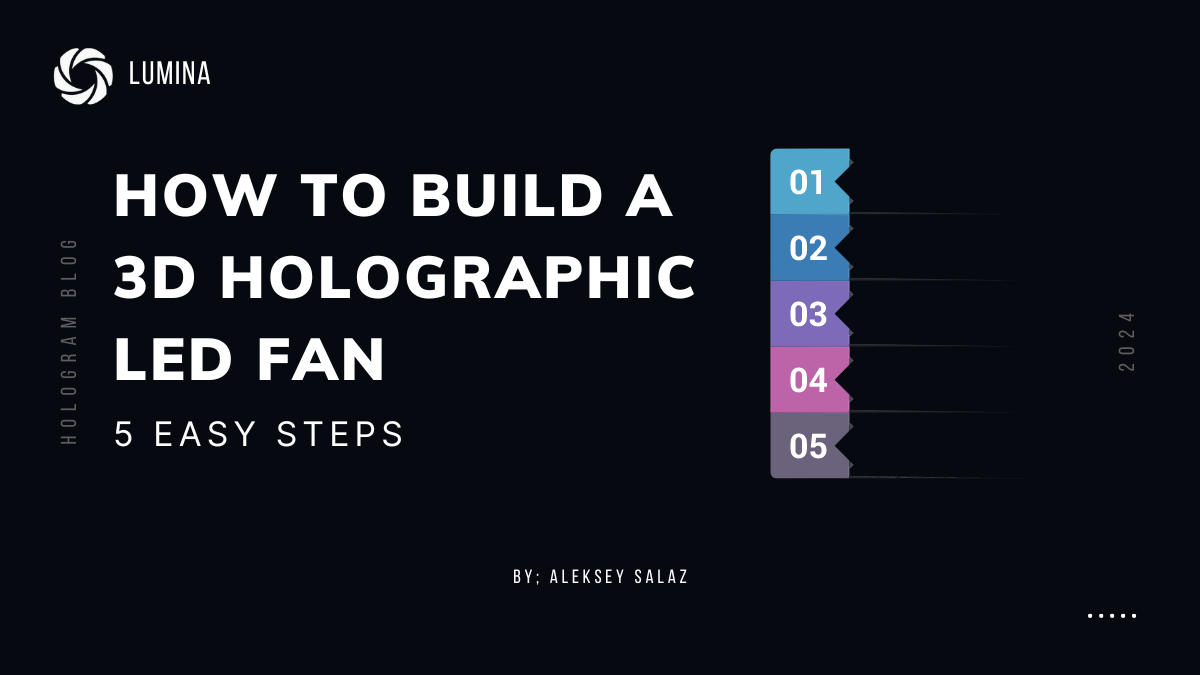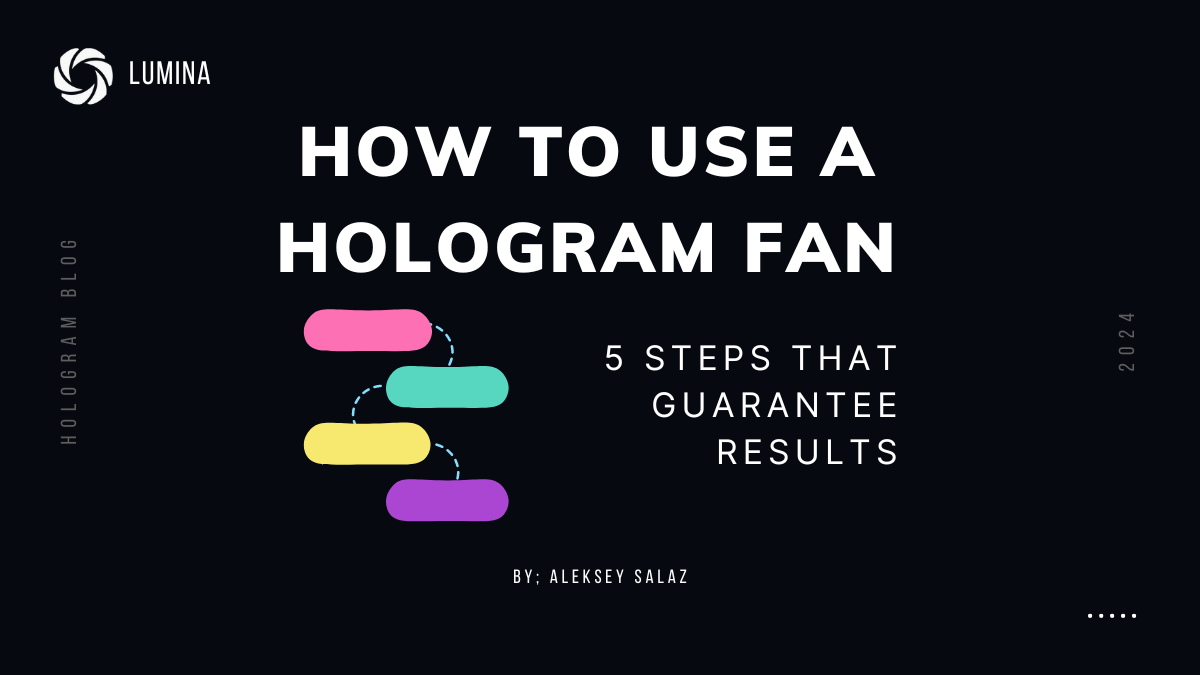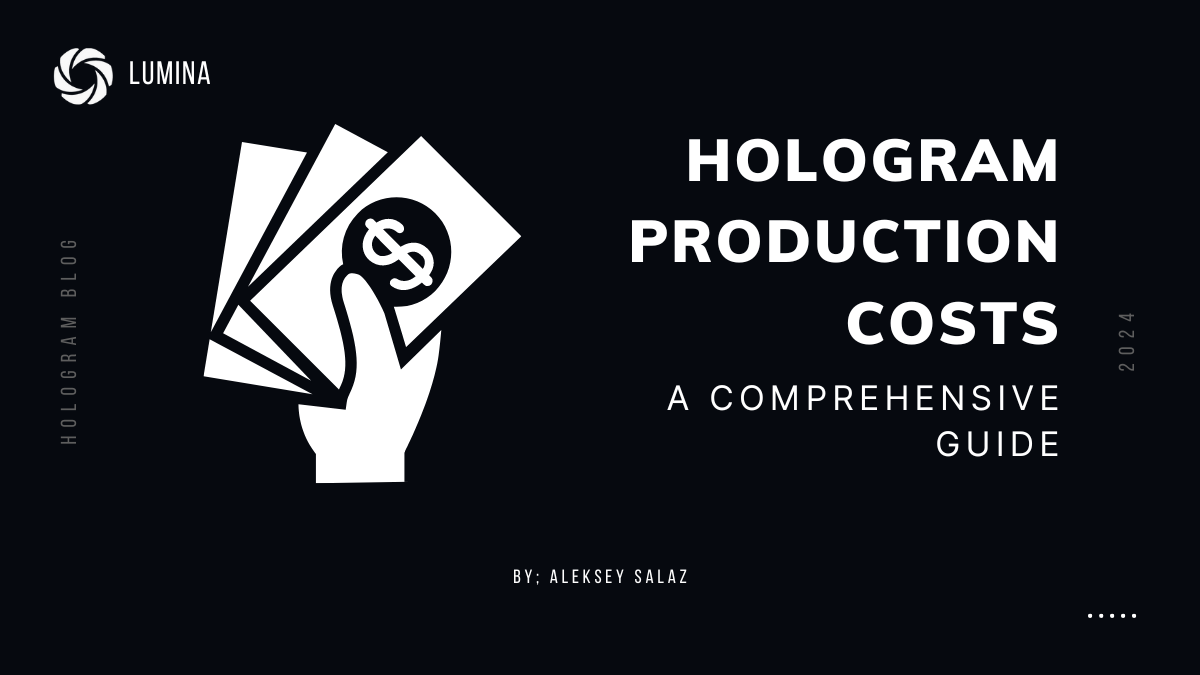Are you eager to grasp attention and distinguish your business from the crowd?
If so, consider creating and implementing a 3D Holographic LED Fan - an alluring piece of tech that generates mesmerizing floating visuals in full HD. Whether you are a savvy marketer or simply a tech enthusiast, constructing this fascinating device offers a unique opportunity to captivate viewers and transform an ordinary space into an extraordinary experience.
In the most basic sense, a 3D holographic LED fan employs a series of LEDs on fan blades spinning at high speeds. The LEDs flash rapidly, creating what appears to be a stable, cohesive, and vibrant 3D image floating in mid-air. This engaging visual spectacle provides a dynamic departure from traditional display mediums, appealing to our innate fascination with illusions and the seemingly impossible.
Brief Overview of 3D Holographic LED Fans
3D Holographic LED Fans are:
- Comprised of fan blades embedded with LED lights, spinning at exceptional speeds.
- Capable of displaying a range of multimedia, including custom content, directly uploaded via apps.
- Able to create ultra-realistic floating 3D visuals in full RGB spectrum, thanks to the high-speed rotation and programmable RGB LEDs.
- Ideal for advertising, presentations, events, and personal entertainment.
With these crucial points serving as a foundation, this article walks you through building your own 3D Holographic LED fan – in 5 easy and well-guided steps, even without expert knowledge or extensive experience.
Importance and Applications of 3D Holographic LED Fans

The appeal of constructing a 3D holographic LED fan extends beyond personal fascination with technology. For businesses, these devices can set you apart in a crowded marketplace by providing a unique, intriguing marketing tool that draws in potential customers and stimulates interactions like never before. From retail displays to trade shows, the potency of these innovative displays elevates the status quo of visual advertising.
Embark on this journey with us, and let's delve into transforming your idea into a captivating reality!
Understanding the Basics of 3D Holographic LED Fans
Before you start your hands-on project on 'how to make 3d holographic led fan', it's integral to understand the underlying principles of these fascinating devices. A 3D holographic LED fan operates by using a rapid sequence of flashing LED lights on spinning fan blades to create a 3D image that seems to float in the air.
How a Hologram Fan is Made
A hologram fan is not your average device. It uses specially-crafted fan blades equipped with LED lights. The blades, typically made from lightweight, robust materials like polycarbonate, spin at high speeds, often exceeding 400 RPM. This speed is crucial for creating the illusion of a 3D image.

These programmable LED lights flash in a sequence at microsecond intervals, producing a broad spectrum of colors. This rapid flashing, synchronized with the fan's speed, creates a stable visual display that appears to float in the air. This phenomenal effect is known as the persistence of vision, where an afterimage lingers in the human eye for a fraction of a second.
How Spinning LED Holograms Work
The magic of spinning LED holograms lies in the speed at which the fan spins. The fan blades need to rotate quickly enough to exploit the persistence of vision, tricking the brain into perceiving a continuous image where there is, in fact, a series of quick flashes. Typically, the fans spin at speeds exceeding 400 RPM, but this speed may vary based on the design and size of the fan.
Is 3D Holographic Projection Possible?
The world of holographic projection is ever-evolving, with new research suggesting that dynamic holographic projection of 3D objects is possible using ultrahigh-density successive planes. This technology allows for fine-grained depth control and reduced crosstalk between planes, opening doors to even more realistic and captivating displays.
In summary, understanding these principles is the first step towards creating a DIY hologram fan. As we guide you through the process, keep these basics in mind. They'll help in making informed decisions and troubleshooting any issues that may arise.
In the next section, we'll discuss the materials you'll need to get started. Your journey towards creating a 3D holographic LED fan begins here!
Gathering the Necessary Materials
Before we get our hands dirty, it's important to gather all the necessary components. Having everything on hand will make the process smoother and more enjoyable. With the right tools, you're already halfway there. So, let's dive into the list of required materials and where to find them.
List of Required Materials and Where to Find Them
Building your own 3D holographic LED fan requires some specific components. Here's a rundown:
- U18 Hall Effect Sensor: This sensor is vital as it helps detect the position of the spinning fan blades. It ensures the LEDs are synchronized to create a clear 3D image.
- Fan: The fan is the backbone of your holographic display. Find a model that's lightweight yet robust. The fan blades will carry the LED lights, so they need to be able to withstand the extra weight.
- LED Lights: These are the magic makers. RGB LED beads are the preferred choice as they allow for full-color displays.
- Arduino Pro Mini: This miniature microcontroller board is the brains of your operation. It controls the LEDs and the Hall sensor.
- FTDI Breakout: You'll need this device for uploading the code to your Arduino.
In addition to these components, you may also need some basic tools such as a soldering iron, wire cutters, and a computer for programming the Arduino and designing your holograms.
You can find most of these components online from various electronics retailers. For those who prefer shopping in person, local electronics or hobby stores are a good bet. Always ensure you're purchasing from reputable sources to avoid counterfeit or sub-par components.
Importance of Each Material in the Construction Process
Each material plays a crucial role in the construction of your 3D holographic LED fan:
- The U18 Hall Effect Sensor is responsible for detecting the position of the spinning blades, which is vital for synchronizing the LEDs to create a clear 3D image.
- The Fan is the foundation of your hologram display. It needs to be sturdy enough to carry the LED lights and spin at high speeds.
- The LED Lights are what create your holographic images. RGB LED beads are key, as they allow for full-color displays.
- The Arduino Pro Mini is the brain of your hologram fan, controlling the LEDs and the Hall sensor.
- The FTDI Breakout is needed to upload the code to your Arduino, making the magic happen.
In our next section, we will guide you through the step-by-step process of building your own 3D holographic LED fan. With the materials gathered and a clear understanding of their purpose, you're ready to learn how to make a 3D holographic LED fan. Let's get building!
Step-by-Step Guide to Building a 3D Holographic LED Fan
Embarking on the journey to build your own 3D holographic LED fan can seem daunting, but with the right guidance, it can be a fun and rewarding project. We at Lumina are here to make the process simpler for you. Let's dive into the step-by-step guide on how to make a 3D holographic LED fan.
Step 1: Building the Circuit Using the Provided Schematic
The first step in building your 3D holographic LED fan is to construct the circuit. Start by connecting your components as per the schematic. Here, the Arduino Pro Mini, which acts as the "brain" of our project, gets connected to the U18 Hall Effect sensor and the LED lights. Make sure to double-check your connections to ensure everything is connected correctly.
Step 2: Uploading the Code to the Arduino Pro Mini
Next, you need to program the Arduino Pro Mini. To do this, you'll use an FTDI breakout board to upload the code. After connecting the FTDI breakout board to your Arduino Pro Mini and your computer, open the Arduino IDE software on your computer. If you don't have it, you can download it from the Arduino website.
Step 3: Assembling the Fan and LED Lights
Once you've successfully uploaded the code to the Arduino Pro Mini, it's time to assemble the fan and LED lights. Attach the LED lights to the blades of the fan. The placement of the LED lights on the fan blades is crucial as it determines how the 3D image will be displayed.
Step 4: Testing and Troubleshooting the 3D Holographic LED Fan
After assembling the fan and LED lights, it's time to test your 3D holographic LED fan. Power it up and watch as the LEDs flash in sequence to create the illusion of a 3D image. If the image doesn't appear as expected, don't worry. Troubleshooting is a normal part of the process. Double-check your connections and ensure the code has been correctly uploaded to the Arduino Pro Mini.
Step 5: Uploading Your Own Videos for a Custom 3D Display
The final step in learning how to make a 3D holographic LED fan is uploading your own videos to create a custom 3D display. This is where you can really let your creativity shine. Whether you're looking to display a cool pattern, a logo, or even a short video, your 3D holographic LED fan can make it happen.
Building a 3D holographic LED fan is an exciting step into digital advertising. With patience, creativity, and a bit of technical know-how, you can create eye-catching displays that are sure to impress. Happy building!
Tips and Tricks for a Successful Build
Building a 3D holographic LED fan is not only fun but also fascinating. To help you get the most out of this project, we've compiled some valuable tips and tricks. These are designed to help you avoid common mistakes and optimize the performance of your fan. Let's dive in!
Common Mistakes to Avoid When Building a 3D Holographic LED Fan
1. Ignoring the Basics: One of the most common mistakes is rushing into the building process without a clear understanding of how the hologram fan works. The fan operates based on the persistence of vision phenomenon. This knowledge is crucial for troubleshooting any issues that may arise.
2. Wrong Material Selection: The choice of fan blades and LED lights is pivotal in creating a convincing 3D image. Using low-quality materials or incorrect LED lights might result in a less effective display.
3. Incorrect Wiring: This can cause your fan to operate poorly or not at all. Always double-check your connections and follow the provided schematic closely.
4. Neglecting to Test: It's crucial to test your fan at each stage of the build process. This allows for early detection of any issues, making the troubleshooting process easier.
How to Optimize the Performance of Your 3D Holographic LED Fan
1. Use High-Quality Materials: The quality of your fan blades and LED lights will greatly impact the quality of your 3D display. Opt for robust, lightweight materials for the fan blades and ensure your LED lights can flash in a sequence at microsecond intervals.
2. Ensure Proper Speed: The speed of your fan is critical in creating a convincing 3D image. The fan needs to spin quickly enough to trick the brain into seeing a continuous image. Typically, fan speeds exceeding 400 RPM are recommended.
3. Test Regularly: Regular testing throughout the building process can help you identify and resolve issues early. This will ensure that your final product operates smoothly and efficiently.
4. Be Creative with Your Display: The beauty of learning how to make 3D holographic led fan is the ability to create custom displays. Experiment with different videos and images to find what works best for your advertising needs.
Building a 3D holographic LED fan is an exciting journey. With the right approach and attention to detail, you can create a device that not only captivates audiences but also revolutionizes your advertising efforts. So, heed these tips, avoid common pitfalls, and start creating your mesmerizing 3D displays today!
Conclusion
Recap of the Building Process
We hope the process of learning how to make a 3D holographic LED fan has been enlightening for you. We've taken you through the fundamental principles of a hologram fan and its operation, harnessing the power of LED lights, fan blades, and the persistence of vision phenomenon. We've also guided you through the essential materials needed for this project, and walked you through the steps of assembling the circuit, programming the hardware, and setting up your 3D display.
In the course of this journey, we've explored the critical role of each component, the importance of the fan's speed, and the sequence of flashing LED lights. By following these steps and understanding the underlying principles, you're well on your way to creating a captivating 3D display that can transform your advertising efforts.
Encouragement for Further Experimentation and Learning
We at Lumina believe in the power of innovation and learning. Building a 3D holographic LED fan is not just about creating a standout advertising tool, but also about unleashing your creative potential and learning new skills. So, don't stop here. Experiment with different designs, explore various applications, and continue to innovate. Whether you're enhancing your retail displays or making your trade show booth more engaging, the possibilities are endless with 3D holographic LED fans.
Each build is a learning opportunity, and each challenge is a chance to grow. If you encounter hiccups along the way or need further assistance, don't hesitate to reach out to us. We're here to support you in your journey to create mesmerizing 3D displays.
And if you're interested in exploring more innovative solutions for your advertising needs, don't forget to check out our product page which offers a range of high-quality 3D fan screens to meet your specific needs. Our goal is to provide you with the tools and knowledge to captivate your audience in unique and engaging ways.
Always remember, 3D displays is vast and exciting. So, keep exploring, keep learning, and keep creating. We can't wait to see what you'll build next with your newfound knowledge on how to make a 3D holographic LED fan.



